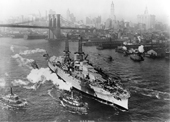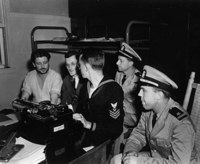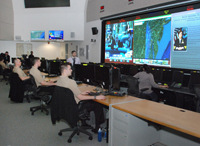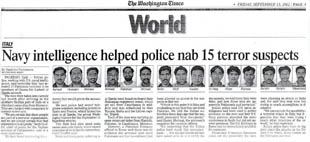An Agent of Change

Within a decade following the end of the American Civil War, the United States Navy had deteriorated into a small collection of obsolete vessels as compared to the major naval powers in Europe, Russia and Japan. By the early 1880’s the government finally acknowledged the need to address the situation. Lieutenant Theodorus Bailey Myers Mason was a young naval officer who was part of a group of reformers intent on modernizing the U.S. Navy.
Mason advocated the creation of an intelligence office to collect and disseminate information on the latest technological developments abroad to support the modernization of the U.S. Navy. ONI's first naval attachés went abroad and acquired as much data and materiel as they could collect about the latest foreign technological advances in naval warfare. ONI played an important role in transforming the American fleet from a wooden ship Navy into a world-class naval power by the turn of the century.
Expanding Missions 
The year 1916 marked a significant turning point for the Office of Naval Intelligence. Congress authorized the first major expansion of ONI's personnel and budget to support domestic security operations, including protecting America's ports, harbors and defense plants from enemy infiltration, subversion and sabotage. ONI worked closely with the departments of State, War, Justice, Commerce and Labor. ONI also censored radio and mail communications to prevent unauthorized disclosure of sensitive defense information.
ONI in World War II
 ONI expanded again during World War II. The Special Activities Branch provided critical intelligence on German U-boat technology, operations and tactics from prisoner interrogations to Fleet Admiral Ernest J. King’s Combat Intelligence Division to help win the Battle of the Atlantic. ONI produced thousands of ship and aircraft recognition manuals for U.S. forces. ONI’s Photographic Interpretation Center provided trained photographic interpreters to the fleet and produced detailed three-dimensional terrain models used by fleet operators for mission planning. ONI established two intelligence schools that provided hundreds of trained Intel officers to the fleet and forward area commanders.
ONI expanded again during World War II. The Special Activities Branch provided critical intelligence on German U-boat technology, operations and tactics from prisoner interrogations to Fleet Admiral Ernest J. King’s Combat Intelligence Division to help win the Battle of the Atlantic. ONI produced thousands of ship and aircraft recognition manuals for U.S. forces. ONI’s Photographic Interpretation Center provided trained photographic interpreters to the fleet and produced detailed three-dimensional terrain models used by fleet operators for mission planning. ONI established two intelligence schools that provided hundreds of trained Intel officers to the fleet and forward area commanders.
Operational Intelligence
ONI’s Operational Intelligence Section established in 1946, inherited the mission of the wartime Combat Intelligence Division created by Fleet Admiral Ernest J. King. The Special Section (Y1) of the Operational Intelligence Section was directly descended from the Joint Intelligence Center Pacific Ocean Area (JICPOA) organization that operated with great success against the Imperial Japanese Navy in the Pacific Theater during World War II.
The Navy Field Operational Intelligence Office (NFOIO), established in 1957, expanded on the successful exploitation of signals intelligence to provide real-time information about the disposition of enemy forces during World War II. NFOIO provided tailored operational intelligence to support the fleet and other authorized intelligence community and government decision makers during the cold war.
Scientific and Technical Intelligence
World War II made evident the importance of scientific and technical intelligence. In 1945 ONI began hiring civilian experts in a wide range of fields to diversify its technical expertise. The development of the Sound Surveillance System (SOSUS) and the establishment of a dedicated acoustic intelligence facility added important new capabilities to U.S. Navy efforts to deter the threat posed by Soviet submarines armed with strategic nuclear missiles. The Navy Scientific and Technical Intelligence Center (NAVSTIC) was established in 1968 and merged with the Navy Reconnaissance and Technical Support Center (NRTSC) in 1972.
In the 1980s the synergistic efforts of the Navy’s operational and scientific and technical intelligence organizations led to an era of major success vis á vis the U.S. Fleet’s principal adversary, the Soviet Navy. During the Cold War, ONI’s mastery of operational intelligence, deep technical knowledge and leadership in the Navy’s global Ocean Surveillance Information system (OSIS) ensured the U.S. Navy held a consistent advantage over the Soviet Navy.
Consolidation
 Following a series of consolidations of naval intelligence field commands between 1988 and 1993, the Office of Naval Intelligence moved into a newly constructed facility where it was joined by the U.S. Coast Guard Intelligence Coordination Center, which supports domestic maritime missions, and the Marine Corps Intelligence Activity, supporting expeditionary and littoral missions. The Naval Information Warfare Activity became a tenant in 1995. The new facility was named the National Maritime Intelligence Center (NMIC), housing the combined expertise of the sea services' intelligence organizations.
Following a series of consolidations of naval intelligence field commands between 1988 and 1993, the Office of Naval Intelligence moved into a newly constructed facility where it was joined by the U.S. Coast Guard Intelligence Coordination Center, which supports domestic maritime missions, and the Marine Corps Intelligence Activity, supporting expeditionary and littoral missions. The Naval Information Warfare Activity became a tenant in 1995. The new facility was named the National Maritime Intelligence Center (NMIC), housing the combined expertise of the sea services' intelligence organizations.
Transformation
 In 2009 the Chief of Naval Operations (CNO) approved the transformation of ONI into a command with four subordinate commands as Centers of Excellence to improve fleet engagement and deliver penetrating knowledge of adversary navy operations and capabilities. Specializing in scientific and technical intelligence, operational intelligence, information services and technology, and expeditionary and special warfare support, the commands work synergistically to deliver superior tailored intelligence to a wide range of customers worldwide. The Director of National Intelligence designated the NMIC as a "national center for the integration of strategic maritime information." While continuing to perform its traditional missions in support of national leaders, the acquisition community, and the fleet, ONI is also providing critical support to what is now a truly national-level global maritime community of interest, envisioned to include U.S., governmental, academic and industry partners.
In 2009 the Chief of Naval Operations (CNO) approved the transformation of ONI into a command with four subordinate commands as Centers of Excellence to improve fleet engagement and deliver penetrating knowledge of adversary navy operations and capabilities. Specializing in scientific and technical intelligence, operational intelligence, information services and technology, and expeditionary and special warfare support, the commands work synergistically to deliver superior tailored intelligence to a wide range of customers worldwide. The Director of National Intelligence designated the NMIC as a "national center for the integration of strategic maritime information." While continuing to perform its traditional missions in support of national leaders, the acquisition community, and the fleet, ONI is also providing critical support to what is now a truly national-level global maritime community of interest, envisioned to include U.S., governmental, academic and industry partners.
With the vision to harness the power of information-centric disciplines in maritime warfighting, the Navy established the Information Dominance Corps (IDC) in 2009 under the leadership of the Deputy Chief of Naval Operations for Information Dominance (N2/N6). The IDC was redesignated as the Information Warfare Community (IWC) in 2016 to reflect the rising influence of global information systems and the increasing rate of technological creation and adoption. The name change also highlights three fundamental capabilities that form the mission of the Information Warfare Community: providing sufficient overmatch in command and control, understanding the battlespace and adversaries, and projecting power through and across all domains. The IWC has evolved from a multi-disciplinary force to an inter-disciplinary Community, an agile Total Force that acquires, exploits, and employs Information Warfare capabilities to achieve Navy mission requirements. Over 52,000 military and civilian professionals span the information warfare, intelligence, cryptology, meteorology and oceanography, information technology and space cadre. Today, the IWC is organized to sustain Information Warfare as a critical warfighting capability on par with aviation, surface and submarine warfare. ONI supports the IWC by producing meaningful maritime intelligence for strategic, operational and tactical decision makers to maintain the U.S. Navy's superiority over any potential maritime adversary while maintaining worldwide situational awareness of maritime traffic, enabling Global Maritime Intelligence Integration and Maritime Domain Awareness for Homeland Defense.